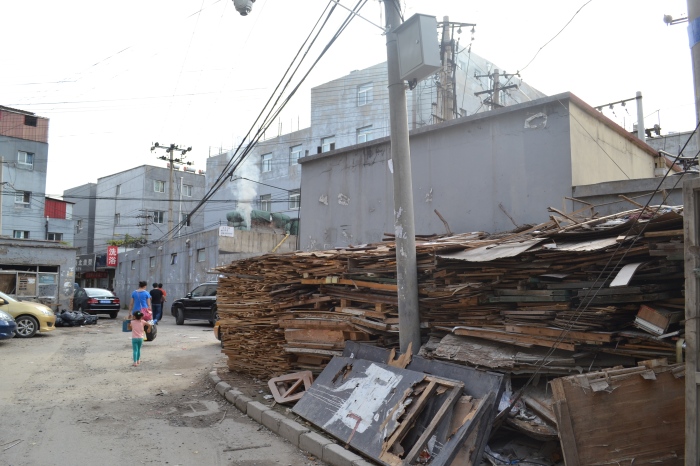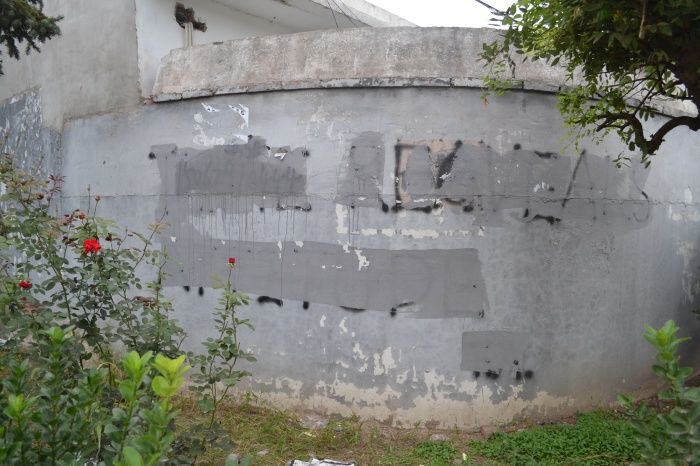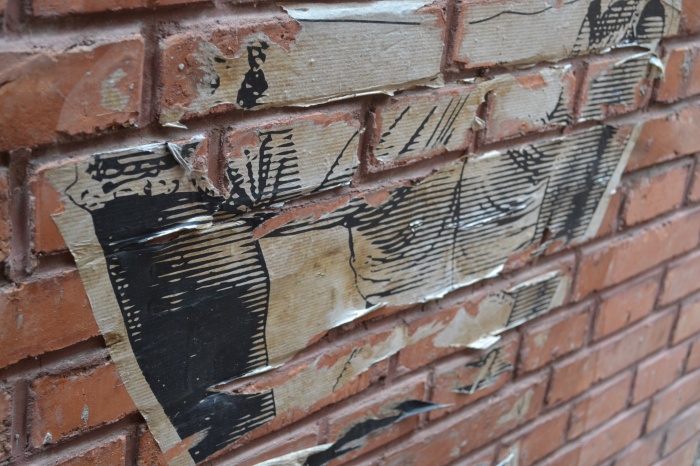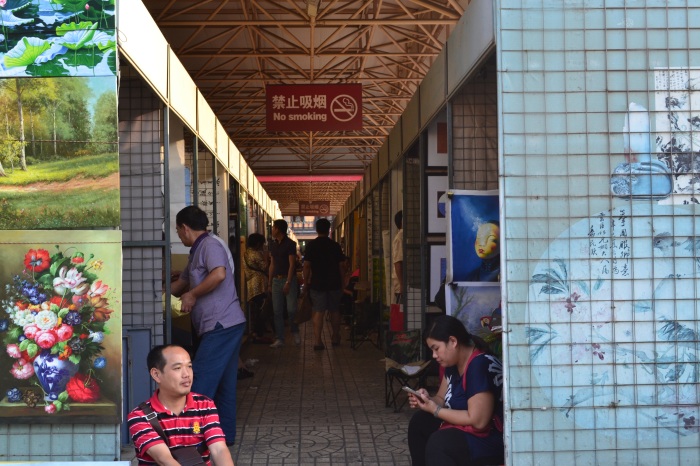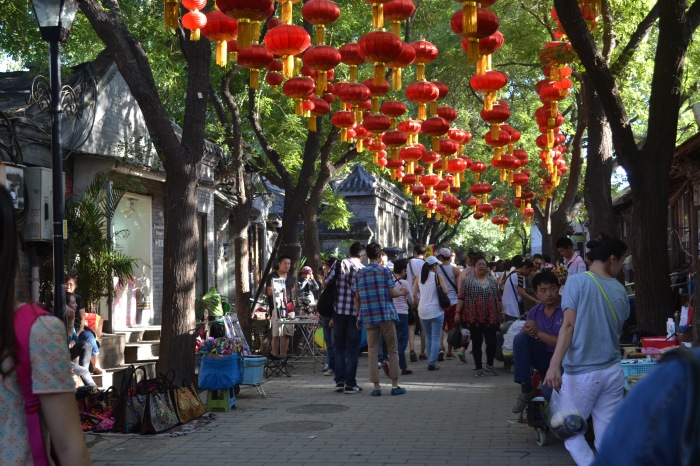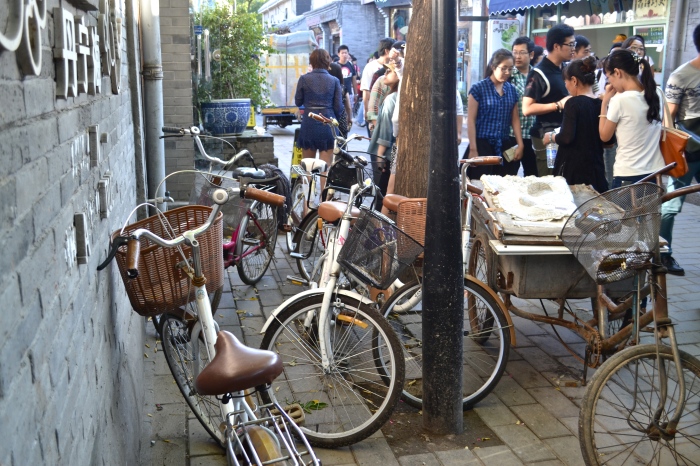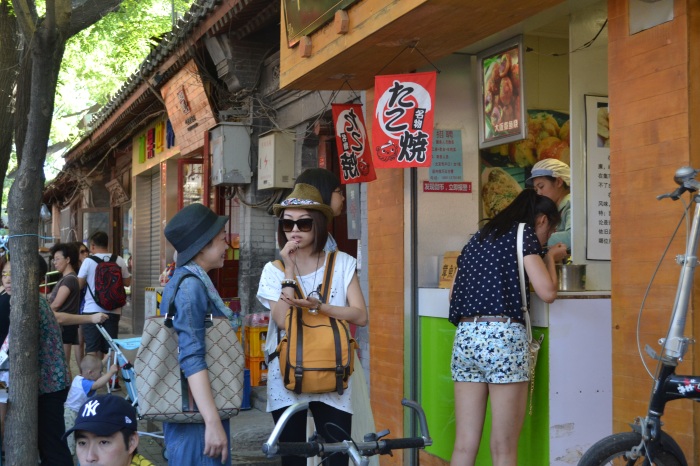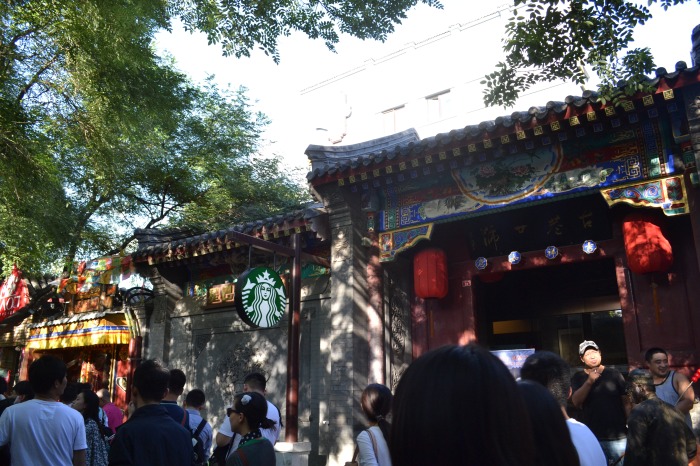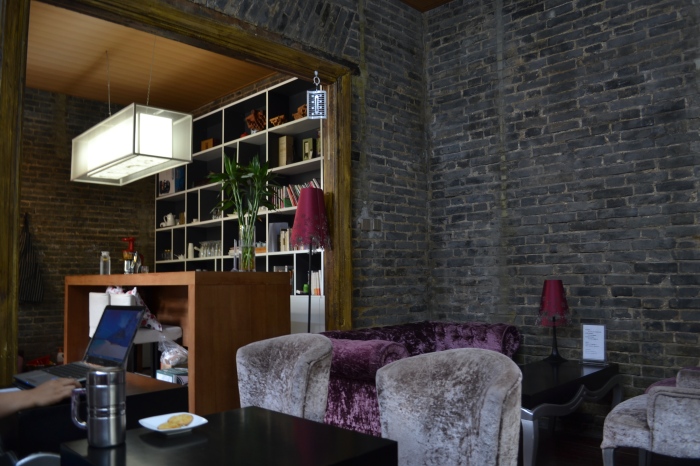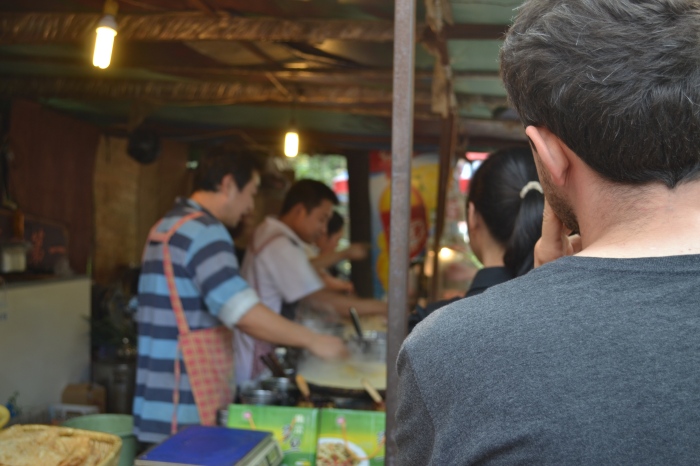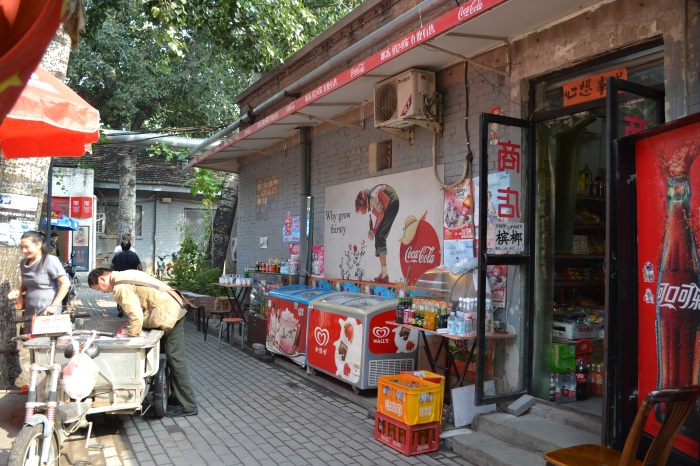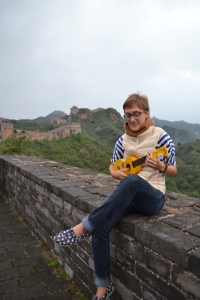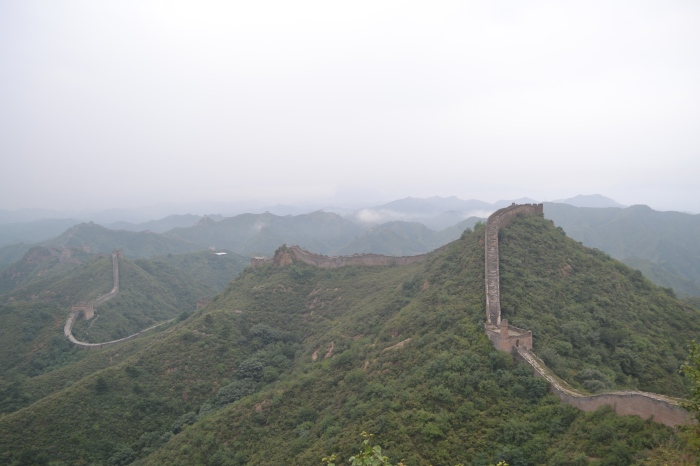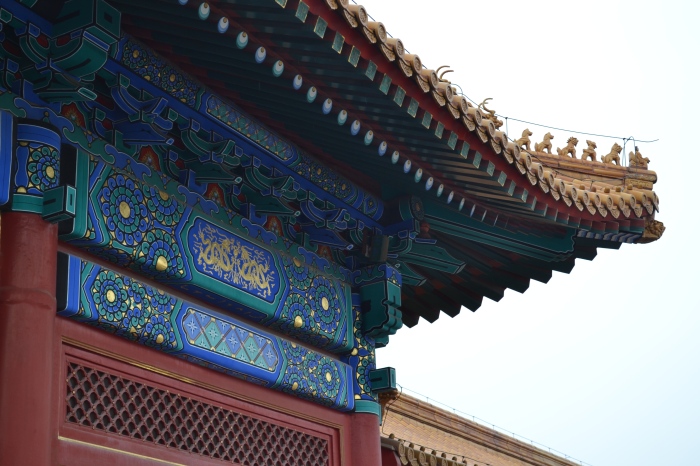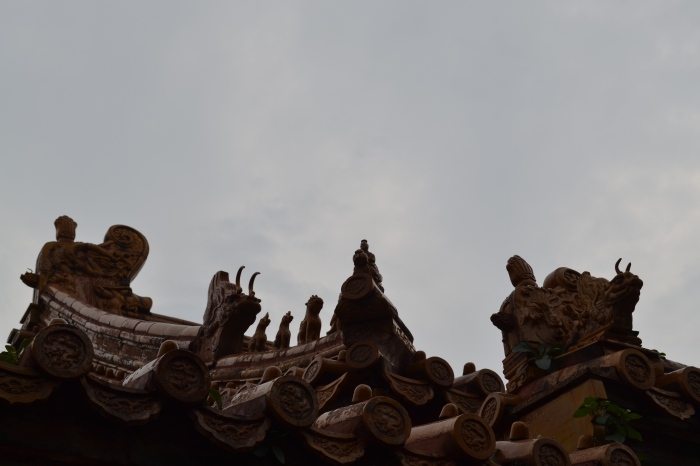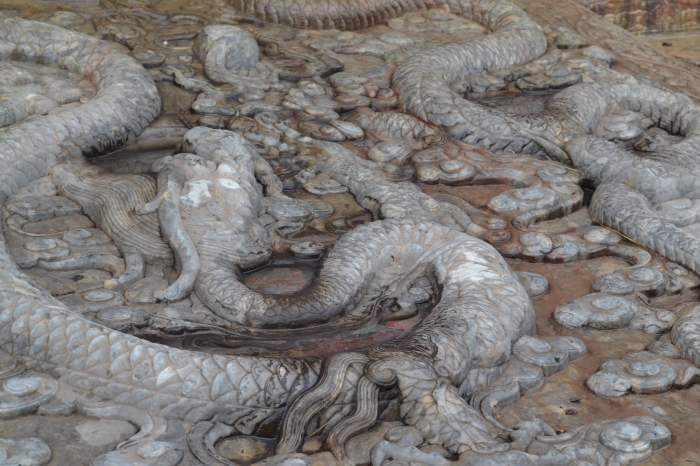I spoke way too soon about all those nice days. I knew they would go away eventually, but yesterday, quite suddenly, I looked outside and couldn’t see most of the city. The air has been horrendous this weekend. And by horrendous, I mean the US Embassy is giving “hazardous” readings every hour, which is as high as their air quality scale goes.
It was nice while it lasted, I guess?
On a more positive note, I went to Caochangdi last weekend. It’s somewhere I’ve been wanting to go for a while, since I came across it doing research for a paper last year.
It definitely did not disappoint, and it prompted a lot of questions and ideas I have around urbanization, community development, and displacement in Chinese cities.
But first, my first impressions:
This is the first thing I saw in the neighborhood called the Caochangdi International Art Village. Caochangdi is considered an urban village, which is the government’s politically correct term for a slum.
I knew that before I went. but still, I was surprised by what I saw. I was expecting something more along the lines of 798 since CCD now has a pretty big international reputation.
Apparently I was on the wrong side of CCD, although interestingly the front gate, which is labelled “Caochangdi International Art Village” takes you straight into the “urban village” part of the neighborhood.
If you turn right and keep walking, though, you end up in the area with all the art galleries.
Which is not that easy to find, if you ask me, because the galleries are mainly in these walled complexes that say very little on the outside, and then only on one wall. The buildings, I think, were designed by Ai Weiwei, and are very oppressive. I like them, but they have a strange atmosphere. On the one hand, it’s a comfortable, unadorned space, but on the other it feels devoid of life and the lively rush of most art districts.
Once you enter through one of the little entryways, you end up in a maze of brick walls with almost no signs except for the occasional name of a gallery in silver letters creeping up the upper corner of a building.
The galleries are fantastic, though. The spaces are all furnished neatly and with beautiful things, but the materials used in the building are raw, with a lot of cement and wood. It gives the spaces an intimate feel, like you’re being allowed into an artist’s studio or home. The closeness of the buildings reinforces this, cloistering you in whichever gallery you visit. Everything is very quiet.
The art was also fantastic. My favorite artists I saw were Chen Haiyan and Xie Xiaoze. Especially Chen Haiyan – there was a small documentary about her process in Ink Studio that was really interesting. She uses traditional calligraphy brushes to paint her subjects (usually her dreams) and then carves out the paintings to use in screenprinting.
Above, people are setting up a pavilion for Beijing Design Week, which is currently going on. Except for them, I saw very few people and felt like I was wandering around an abandoned city.
Even the outside streets, populated by similar forbidding brick buildings, were mostly empty. Maybe it’s not usually like that?
Whereas in 798, the graffiti is large and elaborate, covering every surface in massive illustrations and little doodles, in CCD all the graffiti was done in black and most of it was painted over in the usual gray that cities use when erasing the mark of street artists.
The neighborhood the art galleries were in was strange (along with everything else, pretty much.)
I found CCD sort of hard to navigated because it’s made of these giant complexes. When you’re between complexes, like in the picture above, you’re surrounded by giant walls and trees with very little indication that you’re in what should be a nexus of culture and creativity.
To access that nexus you have to enter the complexes. The gallery side of the neighborhood, then, is the opposite of the urban village side, where the spaces are narrow but cluttered, and where activities like commerce and eating are conducted completely in the open.
It did look like some of the other galleries were more populated, but I didn’t go into them since the bus ride back was pretty long. I did poke around a lot of mysterious gated buildings that had no label indicating what they were and high walls hiding them from the street.
All in all, CCD is a very strange place, and although I want to go back to the galleries soon (probably this week for BJDW), it was unsettling.
Partially because there were internationally renowned galleries, a lot of which have locations abroad, next to an urban village, which is slowly being eaten up to build more galleries. Of course, the people who live in the village are probably making considerable money illegally renting land to artists, which is usual practice in urban villages. Still, the community is slowly being displaced as CCD gains more international attention.
What I find most interesting about this neighborhood is actually the government’s role in its development. At first, I was happy to see the government (any government) taking an interesting in and encouraging the development of the local art scene. CCD was slated for demolition a few years ago, but thanks to community advocacy, demolition was averted. Now, it seems that CCD has the government’s blessing and has been sanctioned as one of the official “art districts” like 798.
In some ways, this is a good thing, since the arts always need all the support they can get, and a lot of the artists in CCD aren’t exactly friendly to the government but still have space to work and exhibit art.
However, I was just reading an article by Ren Xuefei (whose I work I really love) called “Artistic Urbanization: Creative Industries and Creative Control in Beijing”, which made the argument that the Beijing government was creating sanctioned art districts out of organically developed artist neighborhoods in order to institutionalize and control the production of culture. The government exerts control through a combination of state-owned real estate firms who buy and develop land on the peripheries of the city, GONGOs (government organized non-governmental organizations (yes, really)), and village committees (the lowest body of political actors) who work together to create a monitored space for artists where the government can keep an eye on their work and shut it down if it gets too critical.
Essentially what happens, then, is that the government encourages the creation of these spaces but not the development of an artistic community, which naturally needs freedom to prosper. (Also, who’s ever heard of state-sanctioned art? Or rather, state-sanctioned art that’s interesting? Exactly no one.)
The question the article poses, and one that often came up in my Chinese politics last year, is, can a community that relies on free speech thrive in a government-sanctioned space? In my class we talked about this question in relation to Internet censorship, but it’s extremely relevant when talking about artistic communities as well.
A lot of contemporary art in China (by artists like Xie Xiaoze and Ai Weiwei in fact) is very critical of the government (and actually this is the reason some argue China has no contemporary art, since contemporary art is ostensibly free of ideology), like Huang Rui‘s 拆那 piece, which criticized the kind of rural-to-urban development that allows places like CCD to exist.
So can state-sanctioned art spaces become true artistic communities, or will they remain vehicles for “cultural production” that is in line with the government? I’m inclined to say no, especially considering the nature of contemporary art in China, but this is something to think and read more about, if not develop into some kind of project, if possible.
For further reading, I highly recommend anything by Ren Xuefei, who has written on a lot of really interesting topics like architecture and nationalism, green architecture as “spectacle”, and the effects of transnational architecture on Chinese cities, as well as the article discussed above.


